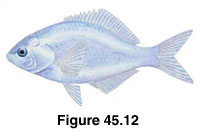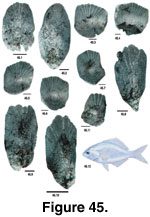 Description
Description
Phanerodon furcatus
(White Seaperch)
(Other common names: White Perch; Silver Seaperch)
Figure 45.12
 Description
DescriptionLength: to approximately 30 cm.
Mouth: small, slightly pointed upward, terminal; upper jaw slightly less than half way to orbit; lower lip attached to lower jaw by a frenum; teeth are fine.
Body: caudal fin is deeply forked; long dorsal fin base with long rays; spinous portion of dorsal fin shorter than soft-rayed portion; the transition from spinous region to soft-rayed region runs in a smooth curve; lateral line parallels dorsal body contour; caudal peduncle is slender.
Color: greenish to silvery above; dark line at the base of the posterior portion of the dorsal fin; fins yellowish; dark edge on caudal fin; dark spot on anterior end of anal fin.
Depth: 43 m.
Habitat: sandy shallow bays; pier areas, offshore near rocky areas.
Season: young born May-August.
Diet: small crustaceans, worms, and mussels.
Predators: not determined.
Distribution: northern Baja, California to Vancouver Island, B.C. (less common in northern waters).
 Scale Description
Scale DescriptionRelative Scale Size: moderate.
Position of Scales on Body: on lateral line canal; also as a sheath of scales on the sides of the dorsal fin (Hart, 1973).
Overall Shape: there are some similarities to the Shiner Perch, but there seems to be a greater degree of variability. The smaller scales are circular to rectangular, while the larger scales are more squared.
Focus and Circuli: the focus is centralized between the four fields. The focus and surrounding circuli are circular and concentric with the outline of the scale. Circuli are continuous from lateral to anterior fields. They are broken and discontinuous in the posterior field.
Radii: numbers are variable and not diagnostic. Present only in the anterior field. The outer edge of the anterior field is scalloped.